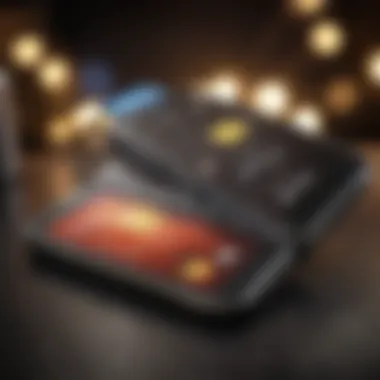Phone Wallets: Transforming Personal Finance Management


Intro
In today's fast-paced world, managing personal finances can feel like a juggling act, where one misstep might send everything toppling down. This is where phone wallets come into play, transforming the landscape of financial management. Gone are the days of rummaging through your pocket for cash or fumbling with cards. With a few taps on a screen, you can handle payments, track expenses, and even set budgets—all from your smartphone.
As the usage of phone wallets grows, understanding their role in financial management is crucial. Not only do these digital tools offer efficiency, but they also present a unique opportunity for individuals to engage more actively in their financial decisions. They bridge a gap between technology and finance in an intuitive manner, seeking to empower users and enhance their financial literacy.
In the sections that follow, we will explore practical applications of phone wallets, ranging from budgeting techniques to retirement planning strategies, illuminating the ways in which these digital platforms can aid in both everyday spending and long-term financial health.
Understanding Personal Finances
Modern financial management requires a basic grasp of personal finances. Many people shudder at the mention of budgeting, but it doesn't have to be a chore. With the right tools—like phone wallets—people can make sense of money matters in ways that are straightforward and rewarding.
Budgeting Techniques
Budgeting isn't just about counting pennies; it's a roadmap. Here are a few techniques that are being increasingly facilitated by phone wallets:
- 50/30/20 Rule: This classic method suggests that 50% of your income goes to needs, 30% to wants, and 20% to savings. Phone wallets can help in visualizing these allocations, making it easier to stay within limits.
- Zero-Based Budgeting: Each dollar is assigned a specific role—expenses, savings, or debt repayment. Many phone wallets offer features that allow you to allocate funds down to the last cent.
Tracking Expenses
Keeping tabs on where your money goes can be eye-opening. Phone wallets often have integrated expense tracking that allows users to categorize their spending habits without fuss.
- Categorization: Expenses can be sorted into categories like dining, entertainment, and bills—helping users to see where they might need to cut back.
- Real-Time Notifications: Alerts can be sent straight to your phone when a purchase is made, keeping you aware and accountable.
Setting Financial Goals
Setting financial goals is akin to nurturing a garden—you must plan, monitor, and adjust. Thanks to phone wallets, establishing and tracking these goals has become simpler.
- Short-Term Goals: These could include saving for a vacation or a major purchase. Users can set milestones in their phone wallets to visualize progress.
- Long-Term Goals: Retirement savings plans are much easier to manage with dedicated features in phone wallets that remind you to keep saving.
"The every dollar counts mentality is part of my everyday life now, and my wallet has been the key to this transformation." - Financial Savvy User
By leveraging the functionalities of a phone wallet, not only can individuals keep their finances in check, but they can also build a brighter financial future. As we continue, we will delve deeper into the investing strategies, retirement planning, and the numerous financial products at your disposal, that further illustrate how phone wallets can enhance our understanding and management of money.
Prolusion to Phone Wallets
In today's fast-paced world, where every penny counts and technology is rife with advancements, understanding phone wallets becomes paramount for anyone striving for financial savvy. Phone wallets, essentially a digital version of traditional wallets, hold the promise of reshaping how we manage finances. They offer a blend of convenience and control that caters to a generation that prefers to do more with fewer physical items.
The significance of phone wallets can be seen in the way they align with modern financial management practices. No longer do we need to fumble through bags searching for cash or cards; instead, everything is neatly packed into our phones. This shift not only simplifies transactions, it also enhances tracking spending habits. One can quickly delve into their expenditure patterns right from their device, which can be pivotal in today’s economy where staying aware of finances is a must.
Moreover, the benefits don't stop at ease of use. Phone wallets often integrate features that allow users to budget effectively, set spending limits, or even receive alerts when they are nearing their budget caps. These tools can motivate individuals to be proactive about their financial health without needing to have a mountain of paperwork or entire spreadsheets.
Defining Phone Wallets
To put it simply, phone wallets are applications installed on smartphones that enable users to store, manage, and use various forms of payment electronically. Imagine having all your credit cards, debit cards, coupons, and even loyalty cards in one handy app; that's what a phone wallet does. It can also facilitate transactions through Near Field Communication (NFC) technology, allowing for contactless payments in brick-and-mortar stores.
Phone wallets facilitate transactions in a seamless manner. A few well-known platforms include Apple Pay, Google Pay, and Samsung Pay. Each of these services uses your existing bank information to create a digital copy, allowing merchants to swiftly process payments, typically with a tap of the phone at checkout.
Brief History of Mobile Payments
The journey of mobile payments, leading to the rise of phone wallets, is quite fascinating. It takes us back to the mid-1990s when the concept of mobile payments first emerged, predominantly in Japan. The first leap into this arena was with the introduction of Felica—a contactless smart card introduced by Sony, which laid the groundwork for what would evolve into modern mobile wallets.
In the early 2000s, many mobile payment services started sprouting, though they were largely limited to specific geographical areas and lacked the universal acceptance needed to thrive. Fast-forward to the launch of Apple Pay in 2014, which marked a pivotal moment; service became more integrated into everyday life, providing momentum for other tech giants to join the fray.
As we progressed, various competitions emerged, pushing innovation and creating better, more secure systems. Technologies such as QR codes and more refined NFC functionalities have opened doors to countless possibilities, providing users with a variety of options for managing their finances on-the-go.
Understanding this history is crucial—not only for enthusiasts who want to be in-the-know, but for anyone wishing to leverage phone wallets for better financial management. Empowered with knowledge, users can exploit the full potential of these tools.
The Evolution of Digital Payment Tools
The journey from cash to digital payments has been nothing short of transformative. We’ve witnessed a seismic shift in how money exchanges hands, and at the crux of this evolution lies the rise of phone wallets. Understanding this evolution is vital, not just for appreciating where we are now, but also for anticipating where we might be headed.
Digital payment tools have effectively redefined our financial interactions. In the not-so-distant past, cash ruled the day. People would physically carry bills and coins, and the only technology involved might have been a calculator for budgeting purposes. As you can imagine, this method came with limitations. Enter the smartphone era – the game-changer for convenience and efficiency in transactions. Digital payment platforms have become essential tools in our daily lives, allowing us to make payments with just a few taps.
Transition from Cash to Digital Payments
Going cashless is not merely about convenience; it’s a reflection of changing consumer habits and preferences. Banks and payment service providers have promoted the transition by emphasizing security and efficiency.
One key example is mobile banking apps, such as Chase Mobile and PayPal, which have drastically reshaped how consumers engage with their bank accounts. Instead of driving to the bank or ATM, you can now deposit checks using your smartphone camera or transfer money instantly to a friend across the globe.
The transition has been propelled by several factors:
- Convenience: No longer do we need to rummage through our wallets for the right change. Just pull out a phone and voila!
- Tracking Spending: Digital payment tools frequently come with budgeting features, making it easier to manage finances on the go.
- Globalization: In a borderless world, digital payments facilitate international transactions with ease, opening a world of commerce.


However, this transition hasn't been seamless. There are hurdles, like the reluctance of some people who find it hard to trust these new methods, preferring the tactile sense of cash. Still, the sheer potential and advantages of digital payments continue to propel them forward.
Impact of Technology on Payment Methods
Technology's influence on payment methods cannot be overstated. It's like a snowball effect where innovations build upon each other, enhancing user experiences and functionalities. For instance, contactless payment technology has made waves in the industry, enabling quick transactions with a simple tap. Who would have thought we’d be waving our phones in front of a terminal instead of swiping cards?
Furthermore, the integration of advanced technologies like Artificial Intelligence and Blockchain has brought a new level of sophistication and security. Just think about how AI can analyze spending patterns to offer personalized insights, or how blockchain technology could make transactions faster and more secure by eliminating intermediaries.
This technological advancement does more than just improve convenience. It also fosters financial inclusivity. With mobile payment options, even individuals in rural areas, where traditional banking infrastructure remains sparse, can access financial services. Now, that’s a powerful impact if you ask me!
"The rise of digital payment tools is not merely a trend, but the new norm that reshapes our interactions with money."
As we look ahead, the evolution of digital payment tools continues to promise an even richer landscape for users. Each development emerges with the potential to empower users, streamline transactions, and further integrate personal finance management into our everyday lives.
Key Features of Phone Wallets
Phone wallets have carved a niche as vital tools in modern financial management, marrying functionality with user-centric design. Their features not only enhance the user experience but also facilitate smoother transactions, promoting financial literacy and accountability among users. Let's explore some of the integral components that make phone wallets indispensable in today’s tech-savvy world.
User Interface and Experience
A seamless user interface is the lifeblood of any app, and phone wallets are no exception. They are crafted to be intuitive, allowing even the least tech-savvy individuals to navigate with ease. With clear icons and straightforward menus, users can quickly access their payment options, transaction histories, and budgeting tools without feeling overwhelmed.
For instance, imagine opening a phone wallet and immediately being greeted by a dashboard showing your spending habits. This kind of visual representation not only makes it easier to grasp where your money goes but also encourages mindful spending.
Furthermore, phone wallets often employ a minimalist design strategy, stripping away unnecessary clutter. This simplicity empowers users to focus precisely on their financial objectives, be it budgeting or planning investments. Ultimately, the user experience impacts how likely individuals are to embrace these technologies in their financial management endeavors.
Integration with Banking Systems
The backbone of any effective phone wallet lies in its ability to seamlessly integrate with various banking systems. This integration fosters a sense of trust among users, as they can link their bank accounts to their phone wallets without a hitch. Linking accounts is typically straightforward, often involving authentication through secure methods like biometrics or two-factor verification.
When banking systems are linked with phone wallets, it opens up a world of possibilities. Users can perform actions like:
- Instant transfers to and from their bank accounts,
- Real-time tracking of their spending,
- Easy management of bills and subscriptions, which helps in avoiding late fees.
Moreover, this integration ensures that users can manage their finances from a single platform. As more banks adopt technology that allows compatibility with phone wallets, the task of monitoring one’s financial health becomes less daunting.
Support for Multiple Payment Methods
The ability of phone wallets to support multiple payment methods is a game changer for users who often juggle different financial resources. Whether it’s credit cards, debit cards, or even loyalty points, a well-designed phone wallet accommodates a range of payment options, ensuring flexibility for diverse spending situations.
For example, when shopping at a grocery store, a user might choose to pay through Apple Pay linked to their credit card while simultaneously saving their loyalty points for future discounts. This kind of versatility not only makes the payment process smoother but also encourages users to maximize the benefits offered by various financial institutions.
In addition, many phone wallets allow for peer-to-peer transactions. Sending money to friends or splitting bills becomes as simple as a tap on a screen. This is particularly appealing to younger generations who prefer quick, hassle-free ways to manage shared expenses.
This flexibility in payment options ultimately contributes to better financial management by allowing users to choose methods that best suit their individual needs,
In summary, the features of phone wallets are central to their success. An engaging user interface, robust banking integration, and the support for diverse payment methods not only smooth out the transactional process but also empower users to take charge of their financial narrative.
Security Aspects of Phone Wallets
The swift rise of phone wallets as staples in personal financial management brings with it pressing concerns regarding security. As these digital tools store sensitive data, understanding their security aspects is crucial. Ensuring the protection of users' financial information not only fosters trust but also encourages widespread adoption. This section delves into the mechanisms safeguarding phone wallets, emphasizing the pivotal role of data protection, authentication measures, and identification of vulnerabilities in these systems.
Encryption and Data Protection
Encryption serves as the backbone for the security of phone wallets. It scrambles information into a format that can only be decoded by users with the appropriate permissions. This makes intercepting data during transactions quite challenging. For instance, AES (Advanced Encryption Standard) is often employed to safeguard data, ensuring that even if malicious entities gain access to the stored information, they won't be able to decipher it without the correct keys.
Data protection isn't solely limited to encryption. Secure servers, regular software updates, and utilizing secure connections (like HTTPS) form a critical shield against potential threats. Moreover, biometric features like fingerprint and facial recognition add another layer of security. Users can feel a sense of relief knowing that their sensitive data is protected by multiple barriers.
"In an increasingly digital landscape, proactive security measures are vital for the protection of personal and financial information."
Authentication Measures
Authentication is the gatekeeper of security, verifying whether a user is who they claim to be. Phone wallets have embraced various authentication techniques, each offering different levels of robustness. Two-step verification, for instance, involves a combination of something the user knows (like a password) and something they have (like a smartphone). This method adds a substantial layer of protection against unauthorized access.
Additionally, the use of biometrics has gained traction. Not just limited to fingerprints, modern wallets often use facial recognition or even voice authentication. This trend reflects a shift towards more user-friendly experiences without compromising security. With these advances, even if someone tries to access a user’s wallet unnoticed, they will likely face significant hurdles.
Assessing Vulnerabilities
No system is infallible, and recognizing vulnerabilities is essential for safeguarding phone wallets. Cyber threats, such as malware and phishing, have evolved, targeting user behavior to extract sensitive information. Users must be educated about potential risks, like clicking on dubious links. Developers also need to stay alert and consistently test their systems for weaknesses.
In particular, regular penetration testing can help in identifying and mitigating threats. This proactive approach allows service providers to assess their security frameworks against real-world scenarios, ensuring they are equipped to handle potential breaches.
The Role of Phone Wallets in Personal Finance
With the significant rise of technology in our daily lives, phone wallets have transformed the landscape of personal finance. They do not merely serve as a storage point for cards but have emerged as comprehensive tools that can enhance financial management through various features and functionalities. The crux of the matter lies in understanding how phone wallets facilitate individual user’s financial health while seamlessly integrating into larger financial ecosystems.


Budgeting Features and Financial Tracking
When it comes to budgeting, phone wallets are like having a mini finance manager tucked away in your pocket. These applications often provide users with the ability to categorize spending. For instance, one can quickly check how much money was spent on groceries last month versus entertainment. This clarity helps in making informed decisions, paving the way for smarter spending habits.
Moreover, many phone wallets have features like setting budget limits. Imagine you allocate a certain amount for dining out – once you hit that limit, notifications can buzz in your pocket, gently reminding you to hold back on those extra fries. Ultimately, such proactive nudges can help users stay on track and avoid impulsive spending sprees.
As individuals become increasingly aware of their spending patterns, phone wallets also enable logging transactions easily. Users can simply snap a photo of their receipts or enter expenses manually, which makes tracking far simpler.
Functions for creating visual reports of expenditures—often through graphs or monthly summaries—also aid in giving users a comprehensive view of their financial behaviors. This data-driven approach allows individuals to identify where they can cut back, thus fostering a more disciplined approach towards budgeting.
Facilitating Controlled Spending
Phone wallets arm users with another layer of control over their finances by including features aimed at fostering disciplined spending patterns. By employing tools like virtual cards that can be loaded with specific funds, users are less tempted to overspend. For example, if someone sets aside a certain amount for entertainment, using a dedicated card for that purpose makes it harder to go beyond the planned expense.
In addition, many wallets offer cash flow insights that can be instrumental in understanding income versus expenditures. This split view can shine a light on areas ripe for adjustment. For those with a tendency to overspend, controlled spending features can be lifesavers, ushering in habits of restraint that students in personal finance cannot ignore.
However, it’s not merely about restrictions but about empowering users. The capability to set goals—whether it’s saving for a vacation or paying off debt—can transform the overall financial landscape. With actionable steps outlined within the app, individuals can see their progress in real time, thus fostering a sense of accomplishment.
"Budgeting isn’t just about limiting what you spend; it’s about making sure your money goes where it matters most."
In summary, phone wallets serve as versatile instruments for achieving financial awareness and control. They encourage users to budget effectively while providing the infrastructure necessary to monitor spending habits, leading to healthier financial practices. The integration of tracking, goal-setting, and controlled spending transforms phone wallets into indispensable assets in the realm of personal finance.
Emerging Technologies Behind Phone Wallets
Emerging technologies are profoundly reshaping the landscape of phone wallets, making them more efficient and user-friendly. These innovations not only streamline financial transactions but also redefine how individuals manage their finances through their mobile devices. Understanding the significance of these technologies is essential for anyone who wishes to navigate the dynamic world of digital finance effectively.
Blockchain Applications in Financial Transactions
Blockchain technology is often viewed as the backbone of cryptocurrencies, but its applications in phone wallets extend much further. By providing a decentralized ledger, it ensures transparency and security in every transaction. For instance, every time you conduct a payment through a phone wallet utilizing blockchain, the transaction is recorded on a distributed ledger that is immutable and tamper-proof.
The benefits here are quite pronounced:
- Enhanced Security: Each transaction gets encrypted, thus making it exceedingly difficult for fraudsters to tamper with data.
- Reduced Costs: Blockchain can eliminate intermediaries, cutting costs for both consumers and businesses.
- Faster Transactions: Financial transactions can be verified in a fraction of the time traditional banking systems require.
Moreover, as the acceptance of blockchain grows, we may witness a metamorphosis in consumer behavior regarding trust and perception of digital payments. Consumers will likely favor systems where they feel their money is secure and their privacy is valued.
"Blockchain’s transparent nature opens the door to greater accountability in financial transactions, fostering a new trust in digital payments."
NFC Technology and Its Impact
Near Field Communication (NFC) technology is another cornerstone of phone wallets. It allows secure, short-range communication between devices, especially during transactions. With NFC, users can simply tap their phone against a point of sale terminal to make a purchase. This convenience is invaluable in fast-paced environments.
The impact of NFC technology is broad-ranging:
- Quick Payments: Transactions occur in seconds, effectively reducing wait times at checkout lines.
- Improved User Experience: Swiping or tapping a phone is often more appealing than fumbling with bank cards or cash.
- Accessibility: Businesses can easily integrate NFC technology into their payment systems without massive overhauls.
As phone wallets continue to integrate NFC capabilities, we see an increasing shift towards a cashless society. Young professionals are particularly drawn to this form of payment due to its simplicity and the growing trend of minimalism in personal finance.
In summation, the marriage of blockchain and NFC technology within phone wallets not only enhances security and speed but also improves overall user experience. What we are witnessing is a significant shift in how we think about money and financial management, a trend that appears poised to grow.
By keeping an eye on these emerging technologies, finance enthusiasts can stay ahead of the curve, adapting their strategies to leverage these innovations for personal gain.
Challenges and Limitations of Phone Wallets
The advent of phone wallets has spurred numerous discussions about their advantages and transformative potential in personal finance management. However, it is crucial to address the challenges and limitations these systems face. Certain barriers can hinder the widespread adoption and efficient usage of phone wallets, and while the technology is promising, understanding its downsides is equally essential for a balanced perspective. This section delves into two significant aspects: technological barriers to adoption and user trust and acceptance issues. Both of these factors are pivotal in shaping the future landscape of financial management through mobile wallets.
Technological Barriers to Adoption
When we consider the landscape of phone wallets, one cannot ignore the hurdles imposed by technological limitations. Though the technology is widely available, several systemic issues can impede user adoption and effective implementation.
Firstly, the disparity in technological infrastructure across different regions is a pressing concern. While urban areas may have robust connectivity and widespread smartphone usage, rural regions might lag far behind. This variance can create a situation where phone wallets are simply not usable for a large segment of the population. It's a bit like having a shiny car but no road to drive it on.
Moreover, the compatibility of phone wallets with existing financial systems presents a unique challenge. Many consumers find that their preferred banking institutions haven’t fully integrated with popular wallet apps, leading to a fragmented experience. It's frustrating to want to use a great tool, only to face the stumbling block of compatibility. This situation doesn't just reduce usability; it also increases the likelihood of user frustration and disillusionment.
There’s also the matter of technical knowledge. Not everyone is tech-savvy, and those who struggle with technology might find it daunting to navigate through digital wallets. This situation can create a barrier to entry, especially for older generations or those without easy access to technology education.
“Technological barriers can act as invisible walls, silently hindering the potential of financial innovation.”
In summary, while phone wallets boast impressive capabilities, the existing technological barriers are significant and must be addressed for broader adoption.
User Trust and Acceptance Issues
User trust is a cornerstone in the acceptance of any digital tool, and phone wallets are no exception. Concerns over security, privacy, and usability weigh heavily on potential users' minds.


Security is perhaps the most significant aspect. Users are increasingly aware of cyber threats and data breaches in today’s digital age. Stories of hacked accounts and stolen information circulate widely, causing anxiety among potential phone wallet users. Despite numerous security measures in place—such as biometric authentication and encryption—these concerns can lead to hesitation. The more a potential user hears about online scams or breaches, the more likely they are to steer clear of these digital wallets. It's tough to shake off a skeptical mindset when one's financial safety feels at stake.
The idea of privacy is another sticking point. Many users are reluctant to relinquish personal data, fearing it may be mishandled or sold without their consent. Transparency in how user data is managed and safeguarded is crucial to alleviating these concerns. Without clear communication, a sense of distrust can quickly bubble to the surface, chilling the adoption drive.
Additionally, there’s an element of social acceptance. Peer influence can play a big role in whether someone decides to embrace new technologies like phone wallets. If a user’s social circle isn't utilizing mobile payments, they may be less inclined to do so themselves, effectively creating a ripple effect. If no one around them confirms the efficacy of such tools, it becomes a hard sell.
In summary, addressing user trust and acceptance issues is paramount for the future of phone wallets in financial management. Unless these concerns are effectively mitigated, the path to widespread use remains bumpy at best.
Future of Phone Wallets in Financial Management
The future of phone wallets holds significant promise in reshaping the landscape of financial management. With the growing penetration of smartphones globally, these digital tools serve as a convenient bridge for users to navigate their financial lives. As we delve into this aspect, it becomes evident that phone wallets are not just a passing trend; they're rapidly evolving into central components of personal finance strategy.
Integration with Financial Services
A major aspect of what will define phone wallets in the near future is their seamless integration with various financial services. The traditional wall between banking, payments, and investments is crumbling, giving way to a more unified experience for users. As phone wallets evolve, they are increasingly starting to incorporate features that allow users to manage not just their spending but also their savings and investments directly from the wallet interface.
- Real-time Transactions: Users can view transactions as they happen, leading to better financial insights almost instantly.
- Banking Connectivity: Integration with banks ensures that money transfer and management is smooth, allowing users to link their bank accounts to facilitate quick transactions.
- Investment Opportunities: Several phone wallets are adding features that allow users to invest in stocks and bonds without leaving the app.
This merging of services simplifies life for users. They can monitor budgets, expenses, and savings all in one place, diminishing the hassle of switching between multiple apps. The impact on financial literacy could be profound, as users gain access to resources and tools that educate them about managing money more efficiently.
Anticipated Trends and Developments
Looking ahead, some intriguing trends are starting to take shape within the phone wallet realm:
- Expansion of AI Capabilities: Many phone wallets are beginning to deploy artificial intelligence to analyze spending patterns. This can lead to tailored suggestions for budgeting, saving, or investing. Imagine a wallet that alerts you when you’re overspending in a particular category or suggests specific savings plans based on your habits; this kind of personalization is not far off.
- Enhanced Security Protocols: Security remains a major concern. Future developments are likely to include more robust encryption methods and biometric authentication, ensuring that users feel secure as they manage their finances digitally. The incorporation of advanced identity verification techniques could play a critical role in building user trust.
- Digital Currencies and Cryptocurrencies: With the rise of digital currencies, some wallets are making inroads into supporting cryptocurrency transactions. This could be a game changer for how users experience their finances, allowing them to hold and trade different currency types directly through their wallets.
- Regulatory Changes: As government policies evolve to accommodate the rise of digital finance technologies, we may see new regulations that either facilitate or complicate the operations of phone wallets. Users will need to stay informed about these changes, as they can influence transaction costs and service availability.
"As we look to the future, it’s clear that phone wallets are not merely about payments anymore; they are becoming all-encompassing financial platforms that can help users take control of their full financial picture."
With these advancements, the potential for fees to decrease and the standard of service to improve grows. The continuous enrichment of features promises to keep users engaged. Overall, phone wallets are on the brink of transforming financial management into a more intuitive experience.
Case Studies: Successful Phone Wallet Implementation
Examining case studies provides invaluable insights into how phone wallets are shaping financial strategies in the real world. Through these examples, we unravel not just the triumphs but also the complexities of adopting mobile payment solutions. By digging into the specifics, we can better grasp the tangible benefits and challenges faced by various sectors when integrating phone wallets into their financial frameworks.
Global Leaders in Mobile Payment Solutions
When it comes to mobile payment solutions, several global players have set the stage for others to follow. Companies like PayPal, WeChat Pay, and Apple Pay aren’t just experimental. They’ve fundamentally changed how we approach transactions nowadays.
For instance, PayPal has expanded beyond peer-to-peer transfers to encompass a variety of retail outlets. Essential elements of its success include:
- User Convenience: The ability to link bank accounts and credit cards makes transactions smoother.
- Wide Acceptance: Partnering with thousands of retailers has positioned PayPal as a staple in ecommerce.
- Security Features: Advanced encryption and buyer protection foster user trust.
On the other hand, WeChat Pay has capitalized on China’s social media landscape, incorporating financial transactions directly into daily communication. Users can split bills, pay for services, or even donate to charities, all within the app. This integration into social interactions has significantly heightened its uptake.
"The future of money will be digital, but how we harness it is up to each market."
Comparative Analysis of Popular Phone Wallets
A comparative analysis allows us to understand the nuances between various phone wallets. Each offers unique benefits, so evaluating them helps users make informed choices aligned with their financial management goals.
Apple Pay: Known for its ease of use, this wallet integrates seamlessly into the Apple ecosystem, offering:
- Touch ID/Face ID Authentication: These features enhance security while simplifying the payment process.
- Limited Availability: While popular in North America, its international acceptance still lags in some regions.
Google Wallet: Google Wallet shines with its versatility:
- Compatibility: It works on a range of devices and platforms, not limiting users to just Android or Google products.
- Loyalty Program Integration: Users benefit from rewards and loyalty programs directly through the app.
Venmo: Originally staring as a cash-splitting tool, it has grown into a full-blown wallet.
- Social Interaction: The social feed feature allows users to see what their friends are up to financially, creating a community feel.
- Limited Use for Retail: Unlike its counterparts, Venmo is mostly used for peer payments, though it is making strides into retail.
Ultimately, the choice of a phone wallet boils down to personal preferences and specific financial needs. The exploration of these case studies doesn't just show us how payments are made but illustrates a shift toward an interconnected financial future, whether it's for budgeting, daily purchases, or international transactions. We’re only at the beginning of this journey as technology continues to evolve to meet our needs.
Concluding Remarks
Understanding the intersection of phone wallets and financial management is crucial in today’s digital landscape. Phone wallets are not just a trend; they represent a pivotal shift in how people manage their finances and engage in transactions. The rise of these tools signals a broader change in consumer behavior and the operational landscape of financial institutions.
Summarizing Key Insights
As we explored throughout this article, several key insights emerge:
- Transition to Digital: Many people are moving away from cash and physical cards. This transition has been driven by convenience and the relentless pace of modern life.
- Budgeting and Tracking: Phone wallets often come packed with features that help users track spending and set budgets, empowering them to manage their finances in a structured way.
- Security Concerns: While phone wallets offer convenience, they also present security challenges that must be addressed. This includes understanding encryption, authentication, and the potential for vulnerabilities in technology.
- Innovative Technology: The advances in technologies like blockchain and NFC are not only reshaping payment mechanisms but also influencing how phone wallets function and interact with users' financial ecosystems.
By aggregating these insights, we realize that phone wallets are more than transactional tools— they are comprehensive platforms for financial management.
Looking Ahead: Financial Empowerment through Phone Wallets
Peering into the future, it’s evident that the evolution of phone wallets will significantly impact financial empowerment. As these tools become more integrated with various financial services, users can expect a more streamlined experience. Here are some trends to keep an eye on:
- Enhanced Integration: We will likely see a deeper integration between phone wallets and other financial platforms. This means seamless transfers between savings accounts, investments, and payment systems, allowing users to manage their complete financial picture in one place.
- Data-Driven Insights: As consumers utilize phone wallets, they will generate data that, when analyzed, can provide personalized insights into spending habits and financial health, guiding smarter financial decisions.
- Increased User Education: With the rise of these tools, there will be a push for user education on managing personal finances effectively through phone wallets.
- Stronger Security Protocols: Innovations in security will not falter, ensuring that as we move deeper into the digital realm, users will have peace of mind knowing their financial information is safer than ever.







